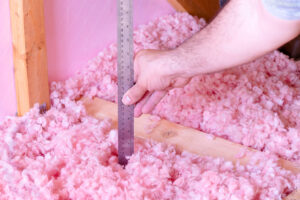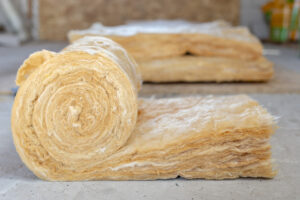There are many benefits of improving your home’s insulation. Among them are added comfort and energy savings. Both fiberglass and cellulose insulation are effective options for residential insulation.
While our team will always help you choose the right insulation for your home, we’ve compiled this list of the pros and cons of each type to help you understand our recommendations.
Fiberglass Insulation
Fiberglass insulation often comes in rolls and batts. Loose-fill fiberglass insulation is also an option, particularly in hard-to-reach spots, or areas where batts are not able to be used.
Manufacturers produce fiberglass insulation from molten sand and recycled glass. Manufacturers add boric oxide to maintain fiber flexibility, which preserves its insulating capacity. Boric oxide is also a fire retardant, and it is pest-resistant. This makes fiberglass insulation a great all-around choice for your home insulation.
Pros
Fiberglass insulation is a cost-effective insulation option that is easy to install and lasts a long time.
1. Ease of installation
For professionals, the installation of rolls or batts insulation is quick and easy. Installers quickly cover open spaces in an attic or crawl space. It is also easy to cut to size when insulating around protrusions such as vents and HVAC equipment and in odd-shaped spaces.
2. Durability
Fiberglass insulation consists of an inert material that lasts for many years. Manufacturers tend to offer generous warranties on fiberglass insulation as well. For example, all Owens Corning fiberglass insulation comes with a 10-year limited warranty. This applies to rolls, batts, and loose-fill insulation.
3. Comfort
Drafty interiors are due to a variety of causes. Inadequate insulation around old or improperly installed windows is one example. During installation, technicians can also seal air leaks in these drafty areas, increasing overall comfort in your home.
4. Sound reduction
Fiberglass insulation reduces sound transmission. New insulation may reduce outside noise or sounds transmitted within the home. This is particularly beneficial for homes on busy streets. Noise Reduction Coefficient (NRC) ratings range from zero to one. Any material with an NRC above 0.65 is a good sound reduction agent. The NRC rating of fiberglass insulation is about 0.90 to 0.95.
5. Inherent fire resistance
Fiberglass is spun from molten glass, which is a non-flammable material. This improves the fire resistance of the insulation, which provides peace of mind for many homeowners. In contrast, cellulose insulation requires significant treatment to follow modern fire codes.
6. Recycled content
Manufacturers often use at least some recycled glass when they create fiberglass insulation. Owens Corning certifies that its fiberglass insulation contains at least 40% recycled content. This is the highest certified level in the industry, making it a great choice for environmentally-conscious homeowners.
Cons
There are a few drawbacks to fiberglass insulation. Rolls or batts may cost more to install in attics with many protrusions (pipes, fans, etc), due to the additional time and labor required. Blown-in loosefill insulation may be preferable in such environments, but loosefill has a lower R-rating, providing less insulation.
1. Energy to produce
Fiberglass insulation requires more energy to produce than its cellulose counterpart. However, in the first year after installation, fiberglass insulation saves about 12 times the energy it takes to produce it.
2. Temperature and moisture sensitivity
When fiberglass insulation becomes wet, it is less efficient. This is because water droplets displace air in the product, reducing the insulation ability. However, it does not lose its insulating capacity as quickly as wet cellulose. Fiberglass is also somewhat more temperature-sensitive than cellulose, causing R-values to slightly decrease in cold weather.
Cellulose Insulation
Cellulose is an insulator that’s been around a long time. Manufacturers can make it from any plant-based material with low thermal conductivity. Recycled paper, cardboard, sawdust, cotton, straw, and hemp are some examples. Loose-fill cellulose insulation is often used for insulating walls, attics, and lofts due to the ease of installation and ability to get into tight spaces.
Pros
The most common raw material in this form of insulation is recycled paper and cardboard. The fact that cellulose insulation is largely a recycled product is a plus for environmentally-conscious homeowners.
1. Effective
Blown-in cellulose insulation is very effective. It has an R-value of approximately 3.2 to 3.8 per inch. A layer about eight to nine inches thick yields an R-30 rating. By comparison, you’d need 12 inches of fiberglass insulation to achieve the same R-30 rating. This makes cellulose a solid option where space is limited, such as within existing walls.
2. Access hard-to-reach places
There are existing walls, attics, and crawl spaces where batts or rolls are not options. Fortunately, blown-in cellulose insulation goes through a hole only one inch in diameter. Installers seal the small hole after the installation, allowing the installer to simply blow cellulose insulation into small or awkward spaces.
3. Comfort
Blown-in cellulose insulation improves indoor comfort by eliminating drafts. In general, cellulose reduces airflow better than fiberglass.
4. Sound reduction
Like its fiberglass counterpart, cellulose insulation is good at absorbing sound. This is particularly true in the mid-range frequencies which covers the range of human speech. This makes cellulose insulation very effective at reducing noise inside the home. Cellulose insulation often has an NRC rating of 0.80 or higher.
5. Pest deterrence
Manufacturers add fire-resistant borates to cellulose insulation. Fortunately, these boron-based additives are also good pest and rodent deterrents, improving peace of mind for homeowners.
6. Less energy to produce
Cellulose insulation requires less energy to produce than its fiberglass counterpart, with some estimates suggesting up to 10 times less energy required.
Cons
With professional installation, the drawbacks to cellulose insulation are minimal. Disadvantages often relate to the fact that it is a loosefill, blown-in insulation.
1. Installation challenges
The installation of blown-in cellulose insulation requires proper ventilation due to the dust that is created. Some pros go with a wet-spray installation method of installation, temporarily dampening the cellulose to reduce dust.
2. Settling
After installation, blown-in cellulose insulation can settle by as much as 20%, reducing its insulating power. Professional installation that anticipates settling is a key to success.
3. Less effective when wet
Cellulose insulation loses R-value when wet. In extreme cases, mold may grow, causing further issues. Proper professional installation addresses this issue before it becomes a problem.
Conclusion
In general, fiberglass insulation is a great choice in more accessible locations, or during the building of a home or addition. Blown-in cellulose insulation works well in existing walls and other hard-to-reach places, where fiberglass may not be a viable option.
The right insulation choice varies from one homeowner to another. Our team of experts will evaluate your needs and budget to help you make a decision that works for you. Either way, you’ll recoup the cost of installation within a few years, and the potential energy savings will keep thousands of dollars in your pocket over time.
Contact Us Today
CRS is a roofing, window, insulation, and siding contractor serving thousands of northern NJ homeowners since 1977. You may have seen our vehicles around your town. Much of our business comes via referrals from satisfied repeat clients.
We have the knowledge and expertise to match the right roofing and siding products with your home’s architectural style. Thanks to factory certifications from Owens Corning and GAF, we offer some of the best warranties in the business. We also carry insurance well above the minimum requirement, to better serve and protect our customers.
We’d welcome the opportunity to learn more about your needs. Please contact us today for prompt, professional, and friendly help.









